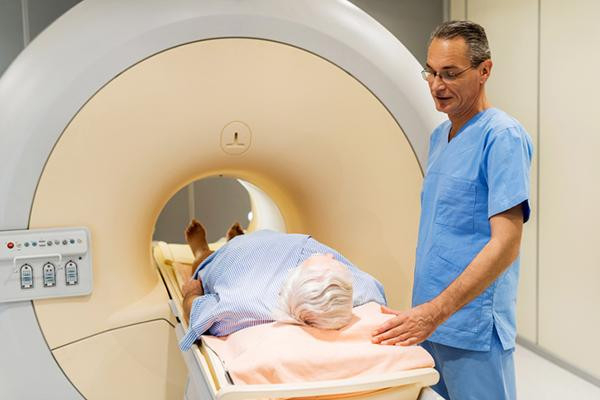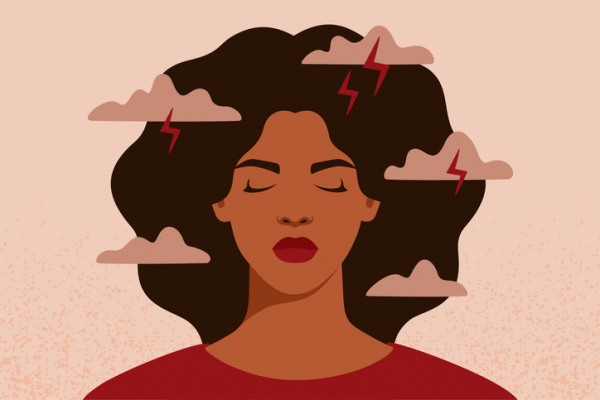
Could imaging scans replace biopsies during prostate cancer screening?

Abnormal results on a prostate-specific antigen (PSA) screening test for cancer are typically followed by a systematic biopsy. During that procedure, doctors use a long needle to extract roughly a dozen samples from the prostate while looking at the gland on an ultrasound machine. Those samples can then be checked for cancer under a microscope.
Limitations and concerns
But systematic biopsies can be problematic. A major concern is that they overdiagnose low-grade, slow-growing tumors that might never become life-threatening, thereby leading to unnecessary treatments.
Researchers are seeking alternatives to the systematic biopsy in men flagged by PSA screening. One option is to start with a magnetic resonance imaging (MRI) scan of the prostate, and then focus the biopsy only on areas that look suspicious for cancer. This is called an MRI-targeted biopsy, and it’s becoming increasingly common.
Could an MRI miss early-stage cancer that later turns out to be incurable? This is an outstanding worry, especially since systematic biopsies sometimes find newly-forming cancer that MRIs aren’t yet able to detect. Indeed, systematic and targeted biopsies are often given together to boost the odds of finding clinically significant disease that may need immediate treatment.
Methodology
Now, a large Swedish study provides encouraging evidence favoring the MRI-only approach.
The team invited 38,316 men ranging from 50 to 60 years in age to undergo PSA screening. If a man’s PSA level was 3.0 nanograms per milliliter (ng/mL) or higher, then he was enrolled into the study. The investigators wound up with 13,153 men who were randomly distributed between two groups:
- Systematic biopsy group: All the men in this group got a systematic biopsy plus an MRI. If a man’s MRI was positive for suspicious lesions, then he also got a targeted biopsy.
- MRI-targeted biopsy group: All of the men in this group got an MRI, but none got a systematic biopsy. Men with suspicious lesions on MRI got a targeted biopsy.
This initial screening round was followed by repeat screening rounds — all following the same protocols — at two-, four-, and eight-year-intervals.
What the study showed
After a median follow-up of 3.9 years (starting from and including the first screening round), prostate cancer had been detected in 185 men from the MRI-targeted group and 298 men from the systematic biopsy group. Systematic biopsies generated more clinically insignificant cancer diagnoses — 159 compared to 68 in the MRI-targeted group. During the first screening round, “The risk of such a diagnosis was 51% lower in the MRI-targeted biopsy group than the systematic biopsy group,” the authors wrote.
The authors emphasized that omitting biopsies in patients with MRI-negative results cut diagnoses of clinically insignificant cancer, meaning cancer that is slow-growing and may never need treatment, by more than half. “And importantly, the associated risk of detecting clinically significant cancer during follow-up and at later screening visits was very low in both groups,” said Dr. Jonas Hugosson, chief urologist at the University of Gothenberg and the study’s first author. “A total of 14 such cases (0.2 % of men who participated) were diagnosed in the systematic biopsy group and eight (0.1 %) in the MRI-targeted biopsy group.”
Commentary from experts
“This study provides encouraging — though very early — data that supports the increasing use of MRI as the first diagnostic modality, following evaluation of an abnormal PSA value,” said Dr. Marc Garnick, the Gorman Brothers Professor of Medicine at Harvard Medical School and Beth Israel Deaconess Medical Center, and editor-in-chief of the Harvard Medical School Guide to Prostate Diseases. “The practice of not automatically going to prostate needle biopsy when an abnormal PSA is detected has gained in popularity in Europe, and this study may help increase its usefulness in the United States.”
“While these results are encouraging, the decision to omit biopsy in men with a negative MRI must be individualized based on the risk of detecting prostate cancer,” added Dr. Boris Gershman, a urologist at Beth Israel Deaconess Medical Center and an assistant professor at Harvard Medical School focusing on prostate and bladder cancer. “For example, biopsy may still be considered in men with markedly elevated PSA, even if the prostate MRI does not identify any lesions.”
About the Author

Charlie Schmidt, Editor, Harvard Medical School Annual Report on Prostate Diseases
Charlie Schmidt is an award-winning freelance science writer based in Portland, Maine. In addition to writing for Harvard Health Publishing, Charlie has written for Science magazine, the Journal of the National Cancer Institute, Environmental Health Perspectives, … See Full Bio View all posts by Charlie Schmidt
About the Reviewer

Marc B. Garnick, MD, Editor in Chief, Harvard Medical School Annual Report on Prostate Diseases; Editorial Advisory Board Member, Harvard Health Publishing
Dr. Marc B. Garnick is an internationally renowned expert in medical oncology and urologic cancer. A clinical professor of medicine at Harvard Medical School, he also maintains an active clinical practice at Beth Israel Deaconess Medical … See Full Bio View all posts by Marc B. Garnick, MD

Evoking calm: Practicing mindfulness in daily life helps

It’s easy to say you simply don’t have time to be mindful. With so much going on in daily life, who has time to stop and be present? But everyone has at least 10 minutes to spare to practice mindfulness.
The point of these brief, daily reflections is to help you tap into calmness whenever life gets too hairy. Practicing everyday mindfulness can also improve your memory and concentration skills and help you feel less distracted and better able to manage stress . And mindfulness tools have been successfully incorporated into treatments for anxiety and depression.
There is more than one way to practice mindfulness. Still, any mindfulness technique aims to achieve a state of alert, focused, relaxed consciousness by deliberately paying attention to thoughts and sensations without passing judgment on them. This allows the mind to focus on the present moment with an attitude of acceptance.
Three easy mindfulness exercises to try
Here are three simple exercises you can try whenever you need a mental break, emotional lift, or just want to pause and appreciate everything around you. Devote 10 minutes a day to them and see how the experience changes your outlook. It’s time well spent.
Simple meditation
A quick and easy meditation is an excellent place to begin practicing mindfulness.
- Sit on a straight-backed chair or cross-legged on the floor.
- Focus on an aspect of your breathing, such as the sensations of air flowing into your nostrils and out of your mouth, or your belly rising and falling as you inhale and exhale.
- Once you’ve narrowed your concentration in this way, begin to widen your focus. Become aware of sounds, sensations, and ideas. Embrace and consider each without judgment.
- If your mind starts to race, return your focus to your breathing. Then expand your awareness again.
- Take as much time as you like: one minute, or five, or 10 — whatever you’re comfortable with. Experts in mindfulness meditation note that the practice is most helpful if you commit to a regular meditation schedule.
Open awareness
Another approach to mindfulness is “open awareness,” which helps you stay in the present and truly participate in specific moments in life. You can choose any task or moment to practice open awareness, such as eating, taking a walk, showering, cooking a meal, or working in the garden. When you are engaged in these and other similar routine activities, follow these steps.
- Bring your attention to the sensations in your body, both physical and emotional.
- Breathe in through your nose, allowing the air to fill your lungs. Let your abdomen expand fully. Then breathe out slowly through your mouth.
- Carry on with the task at hand, slowly and with deliberation.
- Engage each of your senses, paying close attention to what you can see, hear, feel, smell, and taste.
- Try “single-tasking,” bringing your attention as fully as possible to what you’re doing.
- Allow any thoughts or emotions that arise to come and go, like clouds passing through the sky.
- If your mind wanders away from your current task, gently refocus your attention back to the sensation of the moment.
Body awareness
Another way to practice mindfulness is to focus your attention on other thoughts, objects, and sensations. While sitting quietly with your eyes closed, channel your awareness toward each of the following:
- Sensations: Notice subtle feelings such as an itch or tingling without judgment, and let them pass. Notice each part of your body in succession from head to toe.
- Sights and sounds: Notice sights, sounds, smells, tastes, and touches. Name them “sight,” “sound,” “smell,” “taste,” or “touch” without judgment and let them go.
- Emotions: Allow emotions to be present without judging them. Practice a steady and relaxed naming of emotions: “joy,” “anger,” “frustration.”
- Urges: When you feel a craving or an urge (for instance, to eat excess food or practice an unwanted behavior), acknowledge the desire and understand that it will pass. Notice how your body feels as the craving enters. Replace the wish for the craving to go away with the specific knowledge that it will subside.
About the Author

Matthew Solan, Executive Editor, Harvard Men's Health Watch
Matthew Solan is the executive editor of Harvard Men’s Health Watch. He previously served as executive editor for UCLA Health’s Healthy Years and as a contributor to Duke Medicine’s Health News and Weill Cornell Medical College’s … See Full Bio View all posts by Matthew Solan
About the Reviewer

Howard E. LeWine, MD, Chief Medical Editor, Harvard Health Publishing; Editorial Advisory Board Member, Harvard Health Publishing
Dr. Howard LeWine is a practicing internist at Brigham and Women’s Hospital in Boston, Chief Medical Editor at Harvard Health Publishing, and editor in chief of Harvard Men’s Health Watch. See Full Bio View all posts by Howard E. LeWine, MD

Which migraine medications are most helpful?

If you suffer from the throbbing, intense pain set off by migraine headaches, you may well wonder which medicines are most likely to offer relief. A recent study suggests a class of drugs called triptans are the most helpful option, with one particular drug rising to the top.
The study drew on real-world data gleaned from more than three million entries on My Migraine Buddy, a free smartphone app. The app lets users track their migraine attacks and rate the helpfulness of any medications they take.
Dr. Elizabeth Loder, professor of neurology at Harvard Medical School and chief of the Division of Headache at Brigham and Women’s Hospital, helped break down what the researchers looked at and learned that could benefit anyone with migraines.
What did the migraine study look at?
Published in the journal Neurology, the study included self-reported data from about 278,000 people (mostly women) over a six-year period that ended in July 2020. Using the app, participants rated migraine treatments they used as “helpful,” “somewhat helpful,” or “unhelpful.”
The researchers looked at 25 medications from seven drug classes to see which were most helpful for easing migraines. After triptans, the next most helpful drug classes were ergots such as dihydroergotamine (Migranal, Trudhesa) and anti-emetics such as promethazine (Phenergan). The latter help ease nausea, another common migraine symptom.
“I’m always happy to see studies conducted in a real-world setting, and this one is very clever,” says Dr. Loder. The results validate current guideline recommendations for treating migraines, which rank triptans as a first-line choice. “If you had asked me to sit down and make a list of the most helpful migraine medications, it would be very similar to what this study found,” she says.
What else did the study show about migraine pain relievers?
Ibuprofen, an over-the-counter pain reliever sold as Advil and Motrin, was the most frequently used medication in the study. But participants rated it “helpful” only 42% of the time. Only acetaminophen (Tylenol) was less helpful, helping just 37% of the time. A common combination medication containing aspirin, acetaminophen, and caffeine (sold under the brand name Excedrin) worked only slightly better than ibuprofen, or about half the time.
When researchers compared helpfulness of other drugs to ibuprofen, they found:
- Triptans scored five to six times more helpful than ibuprofen. The highest ranked drug, eletriptan, helped 78% of the time. Other triptans, including zolmitriptan (Zomig) and sumatriptan (Imitrex), were helpful 74% and 72% of the time, respectively. In practice, notes Dr. Loder, eletriptan seems to be just a tad better than the other triptans.
- Ergots were rated as three times more helpful than ibuprofen.
- Anti-emetics were 2.5 times as helpful as ibuprofen.
Do people take more than one medicine to ease migraine symptoms?
In this study, two-thirds of migraine attacks were treated with just one drug. About a quarter of the study participants used two drugs, and a smaller number used three or more drugs.
However, researchers weren’t able to tease out the sequence of when people took the drugs. And with anti-nausea drugs, it’s not clear if people were rating their helpfulness on nausea rather than headache, Dr. Loder points out. But it’s a good reminder that for many people who have migraines, nausea and vomiting are a big problem. When that’s the case, different drug formulations can help.
Are pills the only option for migraine relief?
No. For the headache, people can use a nasal spray or injectable version of a triptan rather than pills. Pre-filled syringes, which are injected into the thigh, stomach, or upper arm, are underused among people who have very rapid-onset migraines, says Dr. Loder. “For these people, injectable triptans are a game changer because pills don’t work as fast and might not stay down,” she says.
For nausea, the anti-emetic ondansetron (Zofran) is very effective, but one of the side effects is headache. You’re better off using promethazine or prochlorperazine (Compazine), both of which treat nausea but also help ease headache pain, says Dr. Loder.
Additionally, many anti-nausea drugs are available as rectal suppositories. This is especially helpful for people who have “crash” migraines, which often cause people to wake up vomiting with a migraine, she adds.
What are the limitations of this migraine study?
The data didn’t include information about the timing, sequence, formulation, or dosage of the medications. It also omitted two classes of newer migraine medications — known as gepants and ditans — because there was only limited data on them at the time of the study. These options include
- atogepant (Qulipta) and rimegepant (Nurtec)
- lasmiditan (Reyvow).
“But based on my clinical experience, I don’t think that any of these drugs would do a lot better than the triptans,” says Dr. Loder.
Another shortcoming is the study population: a selected group of people who are able and motivated to use a migraine smartphone app. That suggests their headaches are probably worse than the average person, but that’s exactly the population for whom this information is needed, says Dr. Loder.
“Migraines are most common in young, healthy people who are trying to work and raise children,” she says. It’s good to know that people using this app rate triptans highly, because from a medical point of view, these drugs are well tolerated and have few side effects, she adds.
Are there other helpful takeaways?
Yes. In the study, nearly half the participants said their pain wasn’t adequately treated. A third reported using more than one medicine to manage their migraines.
If you experience these problems, consult a health care provider who can help you find a more effective therapy. “If you’re using over-the-counter drugs, consider trying a prescription triptan,” Dr. Loder says. If nausea and vomiting are a problem for you, be sure to have an anti-nausea drug on hand.
She also recommends using the Migraine Buddy app or the Canadian Migraine Tracker app (both are free), which many of her patients find helpful for tracking their headaches and triggers.
About the Author

Julie Corliss, Executive Editor, Harvard Heart Letter
Julie Corliss is the executive editor of the Harvard Heart Letter. Before working at Harvard, she was a medical writer and editor at HealthNews, a consumer newsletter affiliated with The New England Journal of Medicine. She … See Full Bio View all posts by Julie Corliss
About the Reviewer

Howard E. LeWine, MD, Chief Medical Editor, Harvard Health Publishing; Editorial Advisory Board Member, Harvard Health Publishing
Dr. Howard LeWine is a practicing internist at Brigham and Women’s Hospital in Boston, Chief Medical Editor at Harvard Health Publishing, and editor in chief of Harvard Men’s Health Watch. See Full Bio View all posts by Howard E. LeWine, MD